NumPy中reshape和resize的区别与应用
NumPy是Python中用于科学计算的重要库,它提供了许多强大的数组操作功能。在处理多维数组时,我们经常需要改变数组的形状或大小。NumPy提供了两个看似相似但实际上有很大区别的函数:reshape和resize。本文将深入探讨这两个函数的区别、用法以及应用场景,帮助你更好地理解和使用它们。
1. reshape函数概述
reshape函数是NumPy中最常用的数组形状变换函数之一。它可以在不改变数组元素总数的情况下,改变数组的维度和形状。
1.1 reshape的基本用法
reshape函数的基本语法如下:
import numpy as np
arr = np.array([1, 2, 3, 4, 5, 6])
reshaped_arr = arr.reshape(2, 3)
print("Original array from numpyarray.com:", arr)
print("Reshaped array:", reshaped_arr)
Output:

在这个例子中,我们将一个一维数组重塑为2行3列的二维数组。reshape函数返回一个新的数组,而原始数组保持不变。
1.2 reshape的特性
- 不改变原数组:
reshape不会修改原始数组,而是返回一个新的视图。 - 元素总数不变:重塑后的数组元素总数必须与原数组相同。
- 灵活的参数:可以使用-1作为维度参数,让NumPy自动计算该维度的大小。
import numpy as np
arr = np.array([1, 2, 3, 4, 5, 6, 7, 8])
reshaped_arr = arr.reshape(2, -1)
print("Original array from numpyarray.com:", arr)
print("Reshaped array:", reshaped_arr)
Output:

在这个例子中,我们使用-1让NumPy自动计算列数,结果是一个2行4列的数组。
1.3 reshape的高级用法
reshape还支持更复杂的形状变换,如多维数组的重塑:
import numpy as np
arr = np.arange(24)
reshaped_arr = arr.reshape(2, 3, 4)
print("Original array from numpyarray.com:", arr)
print("Reshaped 3D array:", reshaped_arr)
Output:

这个例子展示了如何将一个包含24个元素的一维数组重塑为2x3x4的三维数组。
2. resize函数概述
与reshape不同,resize函数可以改变数组的大小,即可以增加或减少数组中的元素数量。
2.1 resize的基本用法
resize函数有两种使用方式:作为ndarray的方法和作为NumPy的独立函数。
作为方法使用:
import numpy as np
arr = np.array([1, 2, 3, 4, 5])
arr.resize(3, 2)
print("Resized array from numpyarray.com:", arr)
Output:
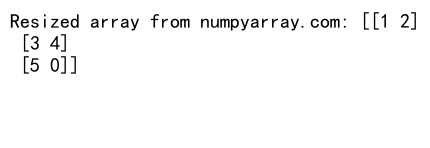
作为独立函数使用:
import numpy as np
arr = np.array([1, 2, 3, 4, 5])
resized_arr = np.resize(arr, (3, 2))
print("Original array from numpyarray.com:", arr)
print("Resized array:", resized_arr)
Output:
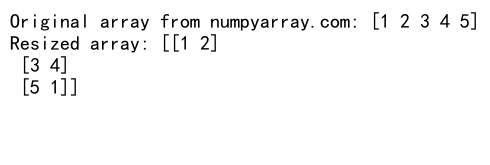
这两个例子展示了如何将一个包含5个元素的一维数组调整为3行2列的二维数组。
2.2 resize的特性
- 可以改变元素总数:
resize可以增加或减少数组中的元素数量。 - 原地操作:作为方法使用时,
resize会直接修改原数组。 - 填充规则:当增加元素时,
resize会重复原数组的元素来填充新位置。
import numpy as np
arr = np.array([1, 2, 3])
resized_arr = np.resize(arr, (2, 3))
print("Original array from numpyarray.com:", arr)
print("Resized array:", resized_arr)
Output:

在这个例子中,原数组只有3个元素,但我们将其调整为2×3的数组,多出的元素通过重复原数组的值来填充。
2.3 resize的注意事项
使用resize时需要注意以下几点:
- 内存分配:当增加数组大小时,可能需要重新分配内存。
- 数据丢失:当减小数组大小时,多余的数据会被丢弃。
- 视图限制:如果数组有多个视图,
resize可能会失败。
import numpy as np
arr = np.array([1, 2, 3, 4, 5, 6])
view = arr[:3]
try:
arr.resize(4)
except ValueError as e:
print("Error from numpyarray.com:", e)
Output:

这个例子展示了当数组有视图时,resize可能会失败的情况。
3. reshape和resize的主要区别
了解了reshape和resize的基本用法后,让我们总结一下它们的主要区别:
- 元素数量:
reshape保持元素总数不变。resize可以改变元素总数。
- 原数组修改:
reshape不修改原数组,返回新视图。resize(作为方法时)直接修改原数组。
- 内存分配:
reshape通常不需要额外的内存分配。resize可能需要重新分配内存。
- 灵活性:
reshape可以使用-1自动计算某个维度。resize需要明确指定所有维度。
- 视图兼容性:
reshape总是可以在有多个视图的情况下使用。resize在有多个视图时可能会失败。
4. 使用场景分析
了解了reshape和resize的区别后,让我们探讨它们各自适用的场景。
4.1 reshape的适用场景
- 数据预处理:在机器学习和深度学习中,经常需要调整输入数据的形状以匹配模型的要求。
import numpy as np
# 假设我们有一批图像数据,每个图像是28x28像素
images = np.random.rand(100, 28, 28)
# 将图像数据重塑为适合某个模型输入的形状
reshaped_images = images.reshape(100, -1)
print("Original shape from numpyarray.com:", images.shape)
print("Reshaped for model input:", reshaped_images.shape)
Output:

- 矩阵运算:某些矩阵运算可能需要特定形状的输入。
import numpy as np
# 创建两个矩阵
matrix1 = np.array([[1, 2], [3, 4]])
matrix2 = np.array([5, 6])
# 将第二个矩阵重塑为列向量以进行矩阵乘法
result = np.dot(matrix1, matrix2.reshape(-1, 1))
print("Matrix multiplication result from numpyarray.com:")
print(result)
Output:

- 数据可视化:在绘制图表时,可能需要调整数据的形状。
import numpy as np
import matplotlib.pyplot as plt
# 创建一个一维数组
data = np.arange(24)
# 重塑为6x4的二维数组
reshaped_data = data.reshape(6, 4)
plt.imshow(reshaped_data)
plt.title("Heatmap of reshaped data from numpyarray.com")
plt.show()
Output:
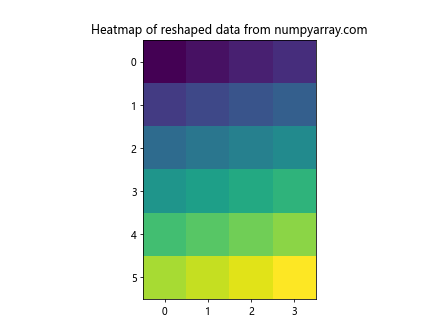
4.2 resize的适用场景
- 动态调整数组大小:当需要在运行时增加或减少数组大小时。
import numpy as np
def dynamic_array_growth(initial_size, growth_factor):
arr = np.array([i for i in range(initial_size)])
print(f"Initial array from numpyarray.com: {arr}")
for _ in range(3): # 增长3次
new_size = arr.size * growth_factor
arr.resize(int(new_size))
print(f"Resized array: {arr}")
dynamic_array_growth(5, 1.5)
Output:
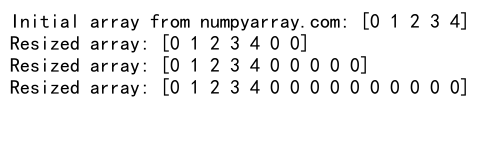
- 数据填充:当需要将小数组扩展到更大的尺寸,并重复原始数据时。
import numpy as np
# 创建一个小的模式数组
pattern = np.array([1, 2, 3])
# 将模式扩展到更大的数组
large_array = np.resize(pattern, (4, 3))
print("Extended pattern from numpyarray.com:")
print(large_array)
Output:
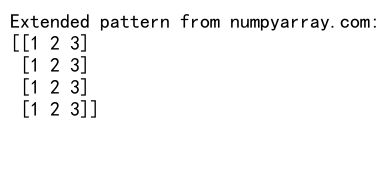
- 数据截断:当需要保留数组的前N个元素时。
import numpy as np
# 创建一个大数组
large_array = np.arange(100)
# 只保留前10个元素
truncated_array = np.resize(large_array, 10)
print("Truncated array from numpyarray.com:", truncated_array)
Output:

5. 性能考虑
虽然reshape和resize都是非常有用的函数,但在使用时也需要考虑性能因素。
5.1 reshape的性能
reshape通常是一个非常快速的操作,因为它不需要复制数据或重新分配内存。它只是创建了一个新的视图,指向相同的内存位置。
import numpy as np
import time
arr = np.arange(1000000)
start_time = time.time()
reshaped = arr.reshape(1000, 1000)
end_time = time.time()
print(f"Reshape operation time from numpyarray.com: {end_time - start_time:.6f} seconds")
Output:

5.2 resize的性能
resize的性能可能会比reshape慢,特别是当需要增加数组大小时。这是因为resize可能需要重新分配内存和复制数据。
import numpy as np
import time
arr = np.arange(1000000)
start_time = time.time()
np.resize(arr, 1500000)
end_time = time.time()
print(f"Resize operation time from numpyarray.com: {end_time - start_time:.6f} seconds")
Output:

6. 常见错误和解决方法
在使用reshape和resize时,可能会遇到一些常见错误。让我们来看看这些错误以及如何解决它们。
6.1 reshape相关错误
- 维度不匹配错误
import numpy as np
arr = np.array([1, 2, 3, 4, 5])
try:
reshaped = arr.reshape(2, 3)
except ValueError as e:
print(f"Error from numpyarray.com: {e}")
# 解决方法:确保新形状的元素总数与原数组相同
correct_reshape = arr.reshape(5, 1)
print("Correct reshape:", correct_reshape)
Output:

- 使用-1时的错误
import numpy as np
arr = np.array([1, 2, 3, 4, 5, 6])
try:
reshaped = arr.reshape(-1, -1)
except ValueError as e:
print(f"Error from numpyarray.com: {e}")
# 解决方法:只在一个维度上使用-1
correct_reshape = arr.reshape(-1, 2)
print("Correct reshape:", correct_reshape)
Output:

6.2 resize相关错误
- 视图存在时的错误
import numpy as np
arr = np.array([1, 2, 3, 4, 5])
view = arr[:3]
try:
arr.resize(10)
except ValueError as e:
print(f"Error from numpyarray.com: {e}")
# 解决方法:创建数组的副本后再调整大小
arr_copy = arr.copy()
arr_copy.resize(10)
print("Resized copy:", arr_copy)
Output:

- 内存不足错误
import numpy as np
try:
huge_array = np.resize(np.array([1, 2, 3]), (1000000, 1000000))
except MemoryError as e:
print(f"Error from numpyarray.com: {e}")
# 解决方法:使用更小的尺寸或考虑使用内存映射数组
smaller_array = np.resize(np.array([1, 2, 3]), (1000, 1000))
print("Smaller resized array shape:", smaller_array.shape)
Output:

7. 高级应用
除了基本用法外,reshape和resize还有一些高级应用,可以帮助我们更灵活地处理数组。
7.1 reshape的高级应用
- 多维数组的展平
import numpy as np
multi_dim_array = np.array([[1, 2, 3], [4, 5, 6], [7, 8, 9]])
flattened = multi_dim_array.reshape(-1)
print("Flattened array from numpyarray.com:", flattened)
Output:

- 转置操作
import numpy as np
arr = np.array([[1, 2, 3], [4, 5, 6]])
transposed = arr.reshape(arr.shape[::-1])
print("Transposed array from numpyarray.com:")
print(transposed)
Output:
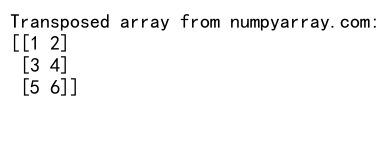
- 创建滑动窗口
import numpy as np
def sliding_window(arr, window_size):
shape = (arr.shape[0]- window_size + 1, window_size)
strides = (arr.strides[0], arr.strides[0])
return np.lib.stride_tricks.as_strided(arr, shape=shape, strides=strides)
arr = np.array([1, 2, 3, 4, 5, 6, 7, 8])
windows = sliding_window(arr, 3)
print("Sliding windows from numpyarray.com:")
print(windows)
Output:
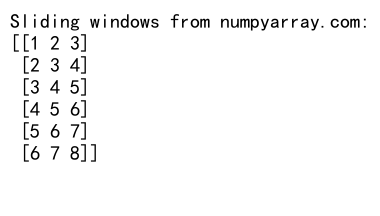
7.2 resize的高级应用
- 创建周期性填充的数组
import numpy as np
pattern = np.array([1, 2, 3])
periodic_array = np.resize(pattern, 10)
print("Periodic array from numpyarray.com:", periodic_array)
Output:

- 动态调整图像大小
import numpy as np
from PIL import Image
# 假设我们有一个图像数组
image_array = np.random.randint(0, 256, (100, 100, 3), dtype=np.uint8)
# 调整图像大小
resized_image = np.resize(image_array, (150, 150, 3))
# 将NumPy数组转换为PIL图像
image = Image.fromarray(resized_image)
print("Resized image shape from numpyarray.com:", resized_image.shape)
Output:

8. reshape和resize在数据科学中的应用
在数据科学和机器学习领域,reshape和resize函数经常被用于数据预处理和特征工程。
8.1 使用reshape进行特征重组
在处理图像数据时,我们经常需要将多维图像数据重塑为二维数组,以便输入到机器学习模型中。
import numpy as np
# 假设我们有一批28x28的灰度图像
images = np.random.rand(100, 28, 28)
# 将图像重塑为二维数组,每行代表一个图像
reshaped_images = images.reshape(100, -1)
print("Reshaped images for ML model from numpyarray.com:", reshaped_images.shape)
Output:

8.2 使用resize进行数据增强
在处理不平衡的数据集时,我们可以使用resize来增加少数类的样本数量。
import numpy as np
# 假设我们有一个少数类的特征数组
minority_class = np.array([[1, 2], [3, 4], [5, 6]])
# 使用resize增加样本数量
augmented_data = np.resize(minority_class, (10, 2))
print("Augmented data from numpyarray.com:")
print(augmented_data)
Output:
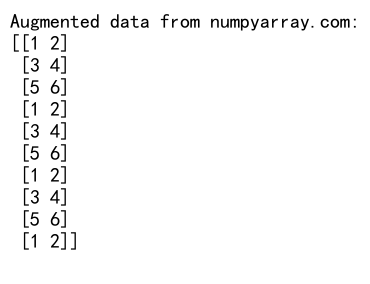
9. reshape和resize的替代方法
虽然reshape和resize是非常有用的函数,但在某些情况下,其他NumPy函数可能更适合。
9.1 transpose和swapaxes
当需要改变数组的轴顺序时,transpose和swapaxes可能比reshape更直观。
import numpy as np
arr = np.array([[1, 2, 3], [4, 5, 6]])
transposed = np.transpose(arr)
swapped = np.swapaxes(arr, 0, 1)
print("Original array from numpyarray.com:")
print(arr)
print("Transposed array:")
print(transposed)
print("Swapped axes array:")
print(swapped)
Output:
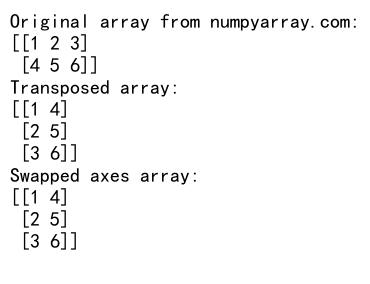
9.2 concatenate和stack
当需要增加数组的大小时,concatenate和stack可能比resize更灵活。
import numpy as np
arr1 = np.array([1, 2, 3])
arr2 = np.array([4, 5, 6])
concatenated = np.concatenate((arr1, arr2))
stacked = np.stack((arr1, arr2))
print("Concatenated array from numpyarray.com:", concatenated)
print("Stacked array:")
print(stacked)
Output:

10. 性能优化技巧
在使用reshape和resize时,有一些技巧可以帮助我们优化性能。
10.1 使用连续内存布局
当数组的内存布局是连续的时候,reshape操作会更快。
import numpy as np
import time
# 创建一个非连续数组
non_contiguous = np.arange(1000000)[::2]
start_time = time.time()
reshaped_non_contiguous = non_contiguous.reshape(250000, 2)
non_contiguous_time = time.time() - start_time
# 创建一个连续数组
contiguous = np.arange(500000)
start_time = time.time()
reshaped_contiguous = contiguous.reshape(250000, 2)
contiguous_time = time.time() - start_time
print(f"Non-contiguous reshape time from numpyarray.com: {non_contiguous_time:.6f} seconds")
print(f"Contiguous reshape time: {contiguous_time:.6f} seconds")
Output:

10.2 避免频繁的resize操作
频繁的resize操作可能会导致性能下降,特别是当数组大小不断增加时。在这种情况下,最好预先分配一个足够大的数组。
import numpy as np
import time
# 频繁resize的方法
start_time = time.time()
arr = np.array([])
for i in range(10000):
arr = np.resize(arr, i+1)
arr[i] = i
frequent_resize_time = time.time() - start_time
# 预分配数组的方法
start_time = time.time()
arr = np.zeros(10000)
for i in range(10000):
arr[i] = i
preallocate_time = time.time() - start_time
print(f"Frequent resize time from numpyarray.com: {frequent_resize_time:.6f} seconds")
print(f"Preallocate time: {preallocate_time:.6f} seconds")
Output:

结论
通过本文的详细介绍,我们深入了解了NumPy中reshape和resize函数的区别、用法和应用场景。reshape是一个强大的工具,用于在不改变数组元素总数的情况下改变数组的形状,而resize则允许我们改变数组的大小,包括增加或减少元素数量。
在实际应用中,reshape通常用于数据预处理和特征工程,特别是在处理图像数据或准备机器学习模型的输入时。resize则更多地用于动态调整数组大小或创建周期性填充的数组。
了解这两个函数的特性和适用场景,可以帮助我们更有效地处理多维数组数据,提高数据处理的效率和灵活性。同时,我们也需要注意它们在性能和内存使用上的差异,以便在实际项目中做出最佳选择。
最后,虽然reshape和resize是非常有用的函数,但在某些情况下,其他NumPy函数如transpose、swapaxes、concatenate和stack可能更适合特定的任务。因此,全面了解NumPy提供的各种数组操作函数,并根据具体需求选择最合适的工具,是提高数据处理效率的关键。
 极客教程
极客教程